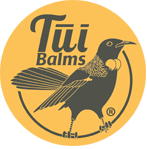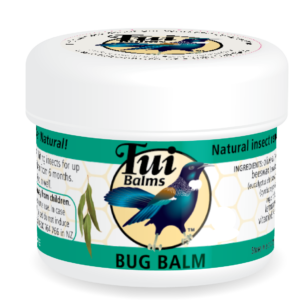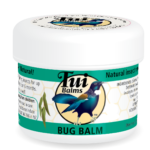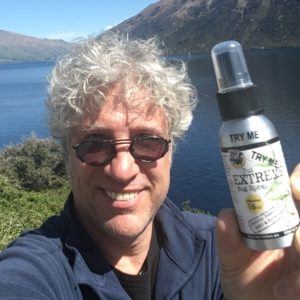Natural Insect Repellent
Tui Balms Guide – Sandflies & Mosquitoes in New Zealand
This guide contains everything you need to know about biting insects in New Zealand and natural insect repellents.
How do you avoid getting bitten by sandflies in New Zealand? Which natural ingredients and essential oils are most effective at repelling sandflies and mosquitoes? Which natural remedies soothe itchy insect bites?
At Tui Balms we’ve been on a mission to find highly effective, natural alternatives which benefit people and our planet. Based in the Abel Tasman National Park since 1984, we pride ourselves on living happily alongside sandflies and mosquitoes! We are happy to share with you what we’ve learnt so far.
Table of Content
Why choose natural insect repellent?
Working in natural skincare since 1984, we witness a growing demand for natural products:
The awareness of potential impacts of chemical ingredients is rising. We may feel cautious as we learn about examples of possible harmful long-term effects, and negative environmental impacts once these substances get disposed of (such as bleaching of coral reefs). As a result many people are preferring products free of synthetic, petroleum or GMO based ingredients, and choosing NATURAL.
There is also an increasing number of people experiencing sensitive skin and looking for effective skincare products that are not irritating to their skin.
One of the biggest reasons for choosing natural insect repellents is that they do not contain chemical active ingredients, most importantly DEET, used in many renown repellents.
What is DEET and why avoid it?
DEET (chemical name N,N-diethyl-meta-toluamide) is a yellow-coloured oil. It was first developed as a pesticide in the United States before being adopted by the US military in 1946. It is known to damage clothing and dissolve plastic as it is a solvent. DEET has been banned in some European countries, like Denmark due to its link to severe skin reactions and neurological problems.

What do natural insect repellents NOT contain?
- No chemical active ingredients, such as DEET or Picaridin
- No genetically modified ingredients (GMO)
- No artificial preservatives
- No emulsifiers, colouring agents or stabilisers
- No chemical additives

And what DO our natural insect repellents contain?
- Active ingredients proven to be effective on NZ sandflies and mosquitoes
- All ingredients sourced from whole natural substances
- Safe options for sensitive skin and children from 6 months of age
- Option of dual purpose repellent and soothing balm for already bitten skin
Which natural ingredients are most effective?
When creating our Bug Balm and Extreme Bug Spray we did extensive research into the botanical ingredients and essential oils which repel sandflies, mosquitoes and other insects. We explored ancient herbal healing traditions through to the latest scientific research and government guidelines.
We then made recipes and tried out different formulas on ourselves. Some intrepid Tui Community members even sat naked in local sandfly and mozzie hotspots, covered in our Bug Spray. Fortunately for them, it worked!
Here’s what we learned.

Our magical ingredient: PMD
We’ll cut straight to the chase: Wanting to pick the most effective natural ingredient, we chose PMD (p-menthane- 3,8-diol) for both our repellents.
PMD is the active ingredient found in lemon eucalyptus and java citronella grass (both listed below). When extracted and concentrated it is known as Citrepel. Because it contains a much higher percentage of insect-repelling PMD, it is more powerful than essential oils alone. It also has fewer irritant impurities, which is good news for our skin!
PMD is the only ingredient endorsed by the World Health Organization (WHO) and the Centre of Disease Control & Prevention (CDP) as a natural repellent ingredient effective against mosquitoes carrying infectious diseases. It works on sandflies, too.
We use only the highest-grade PMD rich botanic oil in our Extreme Bug Spray. Its faint minty smell blends beautifully with lavender.
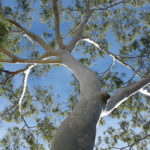
Natural Oils as Repellents
Oil of Lemon Eucalyptus
- This minty, lemony oil is extracted from leaves of the lemon eucalyptus tree, Corymbia citriodora AKA lemon-scented gum tree. Eucalyptus has many anti-inflammatory, analgesic and antimicrobial properties. Lemon eucalyptus is particularly effective at repelling insects because it contains citronella and small amounts of PMD (see above).
Lemon Eucalyptus essential oil
- Sorry to nit-pick, but Lemon Eucalyptus essential oil is actually different from Oil of Lemon Eucalyptus – and less effective. It shares some properties but contains hardly any PMD. Same goes for Eucalyptus essential oil.
Citronella essential oil
- Extracted from Cymbopogon winterianus, often called lemongrass. Its strong, distinctive citrus scent is found widely in insect repellent products, from candles to dog collars. We find Java Citronella more potent than its close-relation, Ceylon Citronella, though both have antiseptic, antifungal and repellent properties. We use Java Citronella essential oil in our Bug Balm.
Lemongrass essential oil
- People often confuse lemongrass with citronella. Although they sound like the same thing, lemongrass essential oil is distilled from Cymbopogon citratus. The grass is a lighter green colour and the lemony scent more gentle – think thai curries and herbal tea. While it shares some repellent properties, you’re better off with Java Citronella.
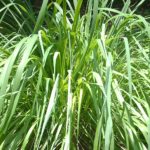
Lavender essential oil
- Distilled from lavender flowers, Lavender essential oil is incredibly versatile and widely used in skincare. It contains an insect-repelling compound called ‘linalool’. While not the most effective option out there, we like using it in combination with other insect-repelling ingredients. Its anti-inflammatory properties soothe any existing sandfly bites.
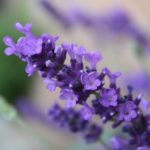
Neem essential oil
- Indigenous to the Indian subcontinent, Neem essential oil is extracted from seeds of the neem tree, Azadirachta Indicia. Used since ancient times in traditional remedies and even to protect crops, it repels insects thanks to its active ingredient Azadirachtin. Bitter-tasting with a yellow-brown hue, its anti-inflammatory and antihistamine properties speed up healing if bitten. Neem blends well with other oils. We use it in our Bug Balm.

Tea Tree essential oil
- Native to Australia, Tea Tree is undoubtedly versatile, with a rich history of natural uses. Its antiseptic and antifungal properties are used for many skin and hair conditions. Some people also find it useful as a natural insect repellent. It didn’t really work for us.
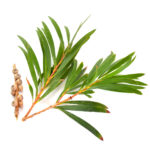
Manuka essential oil
- Although rarely found in insect repellents, we want to acknowledge the traditional Māori use of manuka to repel insects in Aotearoa/New Zealand. Manuka, or Leptospermum scoparium, has many amazing health benefits and a beautiful scent. We use it in our Sports Massage and Myofascial Release Balms – Learn more.
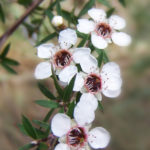
Other essential oils
While they didn’t make our short-list, homemade insect repellent recipes for sandflies, mosquitoes, ticks and fleas can also include:
- Cinnamon bark (Cinnamomum zeylanicum)
- Thyme (Thymus)
- Rose geranium – especially for ticks (Pelargonium graveolens)
- Catnip (Nepeta cataria)
- Orange oil – including Mandarin (Citrus reticulata), Chinese wild mandarin (C. reticulata chinase Blanco) and Sweet orange (C. sinensis Osbeck)
Base oils and carriers
When creating a natural insect repellent, base ingredients are important, too. The base affects ease of application and other characteristics, such as how quickly the oils evaporate and how often you need to reapply.
As well as repellent ingredients we like to include essential oils with soothing and anti-inflammatory properties. This eases the itching of any existing insect bites, conditions the skin and speeds-up the healing process.
Personal preferences to consider:
- Format – some of our team prefer our spray, others our balm.
- Weight – an important consideration when tramping. We introduced smaller sizes for this reason.
- Texture – how it feels on your skin, whether it stays on.
- Potency – consider frequency of application, not just overall percentages of ingredients.
- Scent – our repellents both smell rather lovely. Unlike DEET!
Bug Balm – Our Family Favourite
Bug Balm has a base of beeswax, olive oil and vitamin E. It has a very gentle and soothing application. Our gentlest natural insect repellent.
It contains java citronella, neem oil and Citrepel75 (PMD) to repel insects for 2 to 4 hours. Lavender essential oil is included for both its repelling and soothing properties along with vitamin E to assist the healing process.
Tui Bug Balm has a wonderful aroma and is easily applied to areas of exposed skin. A popular choice for families with young children and safe to use during pregnancy. Also good for soothing skin that has been bitten.
Natural remedies to soothe insect bites and stings
Some people who react strongly to insect bites choose to take antihistamine tablets or apply hydrocortisone cream.
If you’d like to try some natural alternatives, here are some ideas…
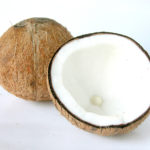
Coconut oil is versatile and soothing. Many people claim it repels insects, too!
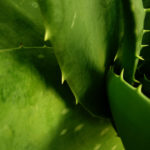
Aloe vera is particularly soothing and super hydrating. We love aloe butter.

Vitamin E promotes healing. Rich in antioxidants, it helps preserve essential oils too.
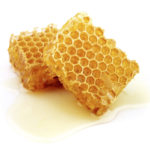
Beeswax is packed with healing, protective properties. We use certified organic beeswax from Canterbury.

Chamomile tea can be applied topically to calm the skin after being bitten.
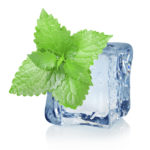
Ice cubes give short-term relief if your bites are bad and you’re not out in the bush.

Maori Legend about the Sandfly
According to Maori legend, on seeing the natural beauty of the Southern Sounds, one of the gods feared that humans would want to live there forever.
So, to remind people of their frailty and mortality, she released the sandflies (namu) and commanded them to fly into the Sounds. They’ve been doing a fantastic job ever since… especially around Milford Sound!
10 Tips to avoid getting bitten by sandflies
The big theme is awareness – being mindful of our environment and behaviour. If we know when we’re most at risk we can adjust our protection accordingly – and live in harmony with the bloodsuckers.
1. Apply natural repellent
Apply repellent as soon as you enter a sandfly zone. Amount and frequency of reapplication varies by repellent. Our Extreme Spray can last up to 6 hours. Our Bug Balm should be reapplied every 2 hours. Put your sun-protection on first if possible. Reapply frequently if you’re sweating heavily or swimming – or if sandflies are particularly dense.
2. Cover up
Wearing long sleeves and pants is the easiest way to keep sandflies from biting you. Thin fabrics are fine – sandfies can’t get through them, unlike mosquitos. Hats and lightweight scarves or shawls can be useful when sitting outside on summer evenings. If you have a baby or small children, take extra care to cover them up.
Socks deserve a special mention: Sandflies love to bite exposed ankles and the soft underside of feet. Throw a pair of socks in your backpack and you won’t regret it.
3. Light colours
Sandflies seem attracted to dark fabrics so wear light colours and use a light-coloured tent if you can. Bonus: it also makes them easier to spot!
4. Weather
Sandflies love muggy, humid, overcast conditions, so remember to take extra precautions on such days – or maybe escape up above the bush line! They also hang out in shady, sheltered spots when the sun is hot, just like humans do. On the other hand, sandflies hate the wind and aren’t keen on rain either, so make the most of beautiful breezy days!
5. Water
Sandflies breed in fast-flowing rivers and streams – they’re in their element here. Expect them to be present near waterways, lakes, estuaries and beaches.
This is probably why it means so much to us when local fisherman Jules Evans recommends our Extreme Bug Spray:
“I have had an entire year to test the Tui Bug Spray in some of the highest density sandfly areas in the South Island, including Fjordland, South Westland and and the Kahurangi National Park. In these areas, combating the “flying teeth” can make or break a day in our wilderness adventures.
I’ve had a 30 year search for an answer to this problem, and in 2016, I finally found it, Tui Bug Spray! I recommend it to anyone I meet in the field and would not send a client into the bush without it. Try it, or regret it, it’s that simple.”
Jules Evans, NZPFGA fishing guide

6. Movement
Sandflies are like nature’s personal trainers. Keep moving, walking or cycling and you don’t tend to get bitten. Take a break and they get on your case. Remember to apply repellent as soon as you stop to rest.
7. Food
For some reason sandflies seem most attracted to us when there’s food around, which is a shame for picnics. Be especially on your guard when cooking and eating outside – and make sure you don’t get repellent on your hands when preparing food! Lighting a fire may deter sandflies as they don’t like smoke.
8. Time of day
Sandflies can’t see at night and rarely bite in the dark. They are most active at dawn and again at dusk, so you should be able to sleep soundly.
9. Keep it shut
If you’re travelling around Aotearoa in a camper, remember to close the windows and doors in sandfly hotspots. Or before you know it, your camper will quickly fill up with new friends!
1o. Spare repellent
Keep extra repellent in reserve in various places. One in the bathroom, one in the camper, one in your backpack. You don’t want to be caught short.
Sandflies vs Mosquitoes

What do you need to know about mosquitoes versus sandflies?
- Mosquitoes are most active during the evening and at night. Consider sleeping under a mosquito net if need be. You can even spray the net with Tui Bug Spray during the daytime and it will keep mosquitoes away even better at night.
- Mozzies can bite through thicker fabrics than sandflies. Leggings/tights might not suffice to protect you. Consider wearing thick or baggy clothes. Applying natural repellent to clothing works, too – though if you’re worried about damage, always test a small, discrete patch first!
- Mozzies love stagnant water like ponds and lakes. Watch out for forgotten buckets of water in the garden, as these might be breeding grounds for mosquitoes.
What about the Mount Mauler?
Mount Mauler are tiny midges found on the North Island beaches near Mt Maunganui. They’re known to leave people with nasty red spots that can take ages to heal. We’re delighted to hear that Tui Extreme Bug Spray works on them too. Bring on the beach!

South Island vs North Island
As a rough guide, sandflies are more prevalent in the South Island and mosquitoes are more common in the North Island. Plus, of the three sandfly species that bite, arguably the worst biter (Austrosimulium ungulatum) is only found on the South Island.
Hotspots include the Westcoast, Fjordland, Milford Sound and Stewart Island – including Great Walks like the Milford Track, the Kepler and the Heaphy.
Here in the Abel Tasman, the home of Tui Balms, it’s warm and mild enough to attract both mozzies and sandflies – lucky us! Fortunately our repellents work on both, plus bed bugs, midges, leaches and horse flies.
Where can I buy Tui Balms?
Tui products are sold online and at over 500 retailers throughout New Zealand.

Good news! You can now buy our Bug Balm and Extreme Bug Spray from Department of Conservation (DOC) Visitor Centres in the heart of our National Parks – including Stewart Island and Milford Sound.
